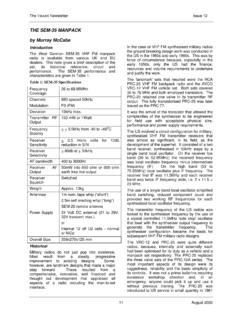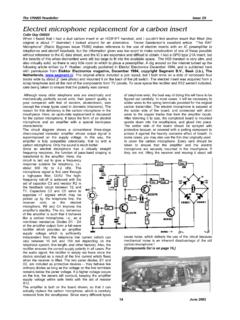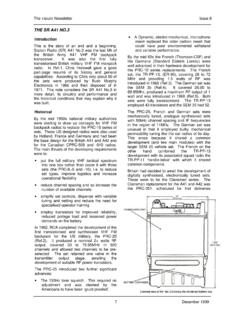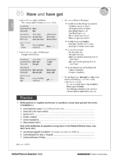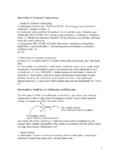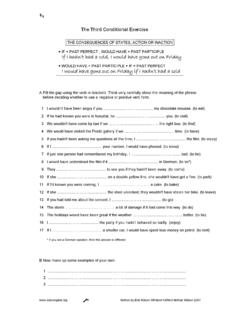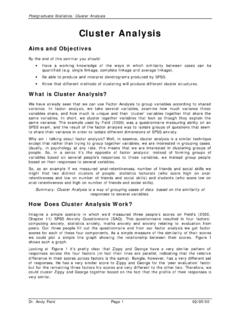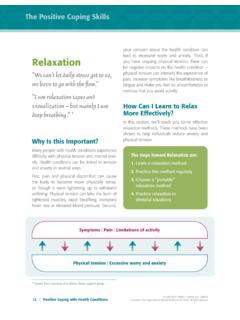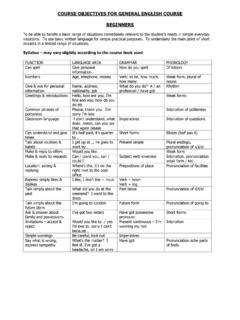Transcription of The Pye Bantam HP1AM - VMARSmanuals
1 The VMARS Newsletter Issue 31 4 October 2003 The Pye Bantam HP1 AMColin Guy G4 DDIThis is another of those radios that was once sought after by the amateur radio fraternity, but has now become almostforgotten.
2 The first time I came across one was when Mr. Rushton, the local GPO Radio inspector, turned up andinformed me that there had been a complaint of TVI from a neighbour of mine. After giving my transmitter a clean bill ofhealth (well, almost, it needed a few tweaks!) he plonked a large canvas bag with a Pye logo on the front of it on thebench, and produced a telescopic aerial and a small blue microphone from within. I was told to await a call via thismysterious bag, then to operate my transmitter until told to stop.
3 Also, if a reply was required, I was to use the callsign Fen Post 2 , and the GPO man was Fen Post 1 .After our man trundled off, naturally I hada sneaky look in this bag, inside was a pairof enormous Ever Ready dry batteries(PP1? not sure), connected to a bluebox half the size of the batteries via aBulgin connector similar to the type usedfor mains supply on later Pye basestations. Eventually the call came throughand the TVI problem was pronounced tobe a defect in the neighbours Mr.
4 Rushton told me that hisBantam had caused interference on theTV set as well!! Happy the following years I saw the oddBantam for sale at the more upmarketrallies but a prices well out of my reach. Eventually I cameacross one in the flesh whilst doing pmr repairs for a local vet,and got to know what they were made of. I also discoveredthat in fact there was room for an internal battery, variousoptions were available: a tray to hold AA dry cells, arechargeable Ni-Cad or external supply as in the Post interest in these was rekindled last year when I cameacross a very dilapidated, though complete except for batteryand leather case specimen at the QRP convention.
5 It hadn tsold by the end of the event and I managed to persuade theowner to part with it for , complete with microphone anda set turned out to be a highband AM model so I thoughtabout setting it up on , to be compatible with the othervintage AM VHF gear I have on this frequency. It turned outthat the crystal multiplication factor is the same as the PyeCambridge, and I had some crystals of the right frequencythough the wrong holder.
6 I soon made a pair of HC6u toHC25u adapters. Application of 9 volts to the batteryterminals, crystals in, a few tweaks with the correct trimmingtool and the Bantam was soon producing about a watt ofRF, and the receiver was about as sensitive as theCambridge (not very!) I had to make a sort of batterycassette, and attach a strap to the metal case and out I with using the set to talk back to the Cambridge andalso my SCR522 at various events led me to think aboutlooking for a lowband one to use with 4m AM sets such as theB44, an ad in the Newsletter produced, thanks to memberAlan Hobbs G8 GOJ, a box of four complete sets with leathercases, eight batteries and a charger.
7 Which I then had to lughalf way across London to get the train home. There turnedout to be two lowband AM, one highband AM and a highbandFM set, so I ve got plenty to be going on with. The FMversion is quite different to the AM one, and uses a differentbattery pack (18 volts as opposed the the AM set s volts)The rest of this article refers to the AM set Bantam is a portable transceiver which was first issued inthe mid sixties, uses mostly germanium transistors and is builton a single pcb mounted in a steel chassis, which slides into asteel case 8 high by 5 5/8 wide by 21/16 deep in turnhoused in a leather carrying case.
8 The following description isderived from the manual for these Description - ReceiverThe Bantam receiver employs fifteentransistors and six diodes in a doublesuperheterodyne circuit. Two amplifiersfeed a diode mixer which, with a crystalcontrolled first local oscillator produces afirst i. f. of Mc/s. The two first stages include a crystal bandpassfilter. This is followed by a secondmixer/oscillator to produce the second of455 kc/ s.
9 Two amplifier stages at thisfrequency drive the detector stage which isfollowed by a variable squelch circuit, andnoise limiter and agc circuits. The audiovoltage produced is fed to the section which has twoamplifier stages driving a push pull output stage. The audiooutput can be fed either to the loudspeaker or theelectromagnetic microphone which then acts as an SectionSignal input is fed through the aerial changeover relay contactRLA4 to the tuned circuit L1 and C2, C3.
10 The tuned circuitmatches the aerial impedance of 50 ohms to the inputimpedance of the first amplifier transistor TR1. Thistransistor is connected in a common emitter circuit with theamplified signal output being taken from the transformer T1 inthe collector circuit. The second amplifier stage TR2 has asimilar circuit. The collector of TR2 has two tuned circuits, L2and C7 which is capacitively coupled through C9 to theprimary of T2 which is tuned by C11.

